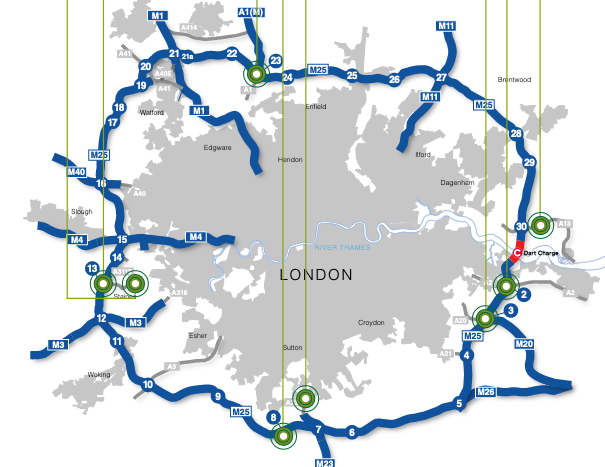Below are the main points and implications of my analysis of the outcome of widening of the M25 motorway between Junctions 23 and 27, published as ‘Economic benefits of road widening’, Transportation Research Part A, 147, 312-319, 2021. Abstract available at https://www.sciencedirect.com/science/article/abs/pii/S0965856421000872 Manuscript available from david.metz@ucl.ac.uk
- The M25 motorway was widened between Junctions 23 and 27 as part of the Smart Motorway investment programme implemented by Highways England. Detailed traffic monitoring reports were published before the scheme was opened and for three years afterwards.
- There was some increase in traffic speeds at Year One after opening, compared with Before opening, but this gain was lost subsequently account of increased volumes of traffic. At Year Three, average daily traffic was up by 16% compared with Before, and up 23% at weekends. This contrasts with an increase of 7% for regional motorway traffic growth.
- The conclusion of the Year Three monitoring report states: ‘These results show that increases in capacity have been achieved, moving more goods, people and services, while maintaining journey times at pre-scheme levels and slightly improving reliability.’ However, this could not have been the basis of the investment case, which in general suppose that travel time savings are the main benefit of transport infrastructure investment. Accordingly, reports of the traffic and economic modelling were obtained; these utilised the long-established SATURN and TUBA models.
- The traffic model projected increased traffic volumes and speeds for the scheme opening year, comparing the ‘do something’ investment case with the ‘do minimum’ case without the investment. However, the increase in traffic volume was less than the observed outturn and the increase in speed forecast failed to materialise beyond the first year after opening.
- The modelled economic benefits derived very largely from time savings for business users. There were also time savings for local users, commuters and others, but these were almost entirely offset by increased vehicle operating costs. This was the consequence of local users rerouting trips between unchanged origins and destinations to take advantage of short journey times made possible by diverting to the motorway, travelling somewhat greater distances.
- The benefits forecast for business users were the main input to the economic appraisal that generated a benefit-cost ratio of 2.9, which was the basis for the investment decision. However, the time savings benefits did not materialise beyond the first year after opening, on account of the additional traffic above forecast.
- The nature of this additional traffic cannot be deduced from the traffic monitoring. It is likely that much, possibly most, comprises local trips rerouting, of no net economic benefit; indeed, these trips would be of negative benefit on account of the additional externalities (carbon etc) arising from the increased distance travelled. The outturn BCR must be much less than the forecast 2.9, possibly even negative.
- This M25 case is likely to be typical in that the Strategic Road Network comes under greatest stress in or near major urban centres where local traffic competes for carriageway with long distance users. Highways England has 10 smart motorway schemes in its current investment programme, with an average BCR estimated as 2.4. This likely reflects considerable optimism bias in the modelling.
- The modelling to support decision making distinguishes between different classes of road user, yet the traffic monitoring does not allow such a distinction. The monitoring is therefore of limited use in refining the models and countering optimism bias. What is needed is monitoring of representative samples of road users over time to see how their travel behaviour changes as the result of the road investment. Such longitudinal studies, as they are known, are common in the areas of health and social sciences, but almost unknown for travel and transport.


[…] and so is yet a further headwind for the DfT’s £27 billion road investment programme. My own analysis of the widening of the M25 J23-27 showed that induced traffic, largely arising from rerouted local […]
[…] of road investment may show major discrepancy between forecast and outturn, for instance for widening the M25 between junctions 23 and 27. One general explanation is the underestimation of the scale of […]
[…] have previously discussed the widening of the M25 motorway between Junctions 23 and 27, where the economic benefits forecast did not materialise. Another […]
[…] the traffic flows after opening were very different from those that had been forecast. For the M25 Junctions 23-27 scheme, the traffic flowed faster one year after opening but subsequently delays reverted to what […]
[…] to take advantage of increased capacity. I have analysed two Smart Motorway investments in detail: M25 Junctions 23-27 and M1 Junctions 10-13. The Smart Motorway concept involves converting the hard shoulder to a […]